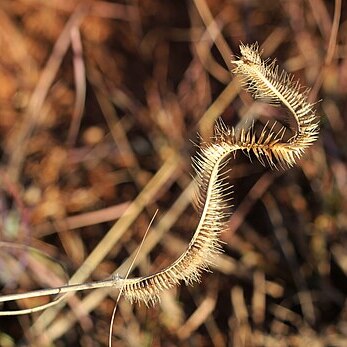Tufted wiry perennial, the basal sheaths broad, becoming chestnut brown and chaffy like wood shavings; culms up to 1 m. high.. Leaf-blades 10–30 cm. long, tightly involute.. Spikes solitary, mostly 6–10 cm. long, curved in an arc, bearded at the summit of the peduncle.. Upper glume 5–6 mm. long, hispidulous; lowest lemma oblong-elliptic, (2.5–)3–3.5 mm. long, ciliate on keel and marginal nerves, densely pubescent between, obtusely cuspidate at the apex, awned from below the tip; second lemma lanceolate, 3–3.5 mm. long, ciliate on keel and marginal nerves, densely pubescent to pilose between, produced into a triangular tongue 0.3–0.5 mm. long above the insertion of the awn; fertile lemma ovate, (3.6–)4–4.5(–5) mm. long, long-ciliate on the marginal nerves with hairs 2–2.5 mm. long, glabrous between, awned from just below the tip with an awn 4.5–5.5 mm. long.
Tufted perennial 400-700 mm high; culms wiry. Leaf blade 100-300 x 2-5 mm; ligule a fringed membrane, fringe sometimes minute. Inflorescence a one-sided spike-like raceme, 50-170 mm long, sickleshaped to corkscrew-like at maturity, beard of silky hairs at base of raceme; spikelets solitary. Spikelet 5-7 mm long; lower glume membranous, 1-nerved, tubercles on nerve; upper glume 2-nerved, one nerve with tubercles, other nerve with an oblique dorsal awn 1/2 way up, spreading at right angles to glume; lemma 4.0-4.5 mm long; 3-nerved, densely pubescent on marginal nerves to pilose between nerves, awned from just below apex on central nerve; awn 4.5-5.5 mm long, straight; anthers up to 2 mm long.
Superior glume 5–7.2 mm long; lowermost lemma (2.5)3–3.5 mm long, oblong-elliptic, ciliate on the nerves and keel, densely pubescent on the back, awned from below the obtusely cuspidate apex; 2nd lemma 3–3.5 mm long, lanceolate, ciliate on the nerves and keel, densely pubescent to pilose on the back, produced into a triangular tongue 0.3–0.5 mm long above the insertion of the awn; fertile lemma 3.3–4.2 mm long, ovate, long-ciliate on the marginal nerves with hairs 2–2.5 mm long, glabrous on the back, with an awn 4.5–5.5 mm long.
Wiry perennial, tufted, up to 0.7 m high. Leaf blades 100-300 mm long, 2-5 mm wide. Spikelets 5-7 mm long. Inflorescence a one-sided spike, 50-170 mm long, sickle-shaped to corkscrew-like at maturity; upper glume tubercled; lemmas awned from below apex on nerves, with a spreading awn on back; female-fertile lemma 4.0-4.5 mm long; awns 4.5-5.5 mm long.
Caespitose perennial up to 110 cm tall; lowermost leaf sheaths broad and stiffly chaffy (rather like wood shavings); leaf laminas 6–30 cm × up to 6 mm, flat or lightly involute.
Raceme 7–21 cm long, straight or curved in a gentle arc or flat spiral, mostly barbate at the base.

